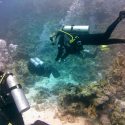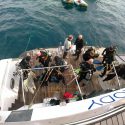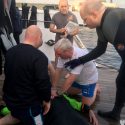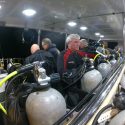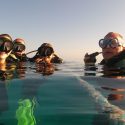The ability to recognise the signs and symptoms of decompression illness or ‘the bends’ as it is commonly referred to, is something that all divers are taught. Being able to respond quickly and effectively could mean the difference between the life and death of the diver concerned. For the expedition members of Exercise Neptune Serpent 20, that ability was to be put to the test very early on.
Comprising 15 members of the Army Reserve and one member of the Regular Army, the participants had been drawn from Units across the UK. From as far North as Edinburgh to London in the south and cities in-between.
Originally scheduled to fly from Manchester, the group were forced to find an alternative flight following the collapse of Thomas Cook airlines. The resultant rescheduling meant an early start for the expedition who would pick up soldiers from their respective Army Reserve centres on the way South to Stansted for the onward flight to Egypt and the Red Sea.
By the time they arrived in Egypt, late on the Friday evening, most of the expedition members had not seen their bed since waking on Thursday morning. However, although the transfer from the airport to the dive boat ‘Blue Melody’ took only 15 minutes, it would be early into Saturday morning before the soldiers would see their beds again.
An early rise on Saturday was not very welcome although the breakfast aromas were and the group were soon enjoying the culinary delights from the galley. Hardly had they finished eating than the cries of “help” were heard from the fin deck at the stern of the boat.
Unnoticed by the still wary group, the expedition supervision team had slipped out of the dining area to stage a Practical Rescue Management (PRM) scenario. A mandated exercise, the PRM is used to practise the expedition members in dealing with a diving related emergency.
All military diving must be carried out under supervision at all times. Expedition Sub Aqua Supervisors (ESADS) are skilled divers who have undergone the ESADS course at Joint Services Sub Aqua Dive Centre (JSSADC) in Plymouth. They are responsible for the supervision of all Adventurous Training diving operations.
The majority of the expedition were novice divers with very little experience. Even those more qualified had not done a great deal of diving. Due to the limitations of the participants, the primary aim of the expedition was to enhance and consolidate diving ability rather than to further diving qualification. However, regardless of diving ability, each of the participants had to understand the scenario they were faced with and also understand how to deal effectively with the casualty.
With breakfast and the PRM out of the way, the majority of personnel set about configuring their dive kit while enjoying some early morning sunshine. While the remainder of the expedition familiarised themselves with the layout of the boat, the dive supervisors set about testing the boat’s compressors, ensuring that the compressed breathing air complied with regulations before the boat was allowed to depart the marina.
Due to the remote location of some sites to be dived, the expedition was also equipped with a satellite telephone. In the event that their rescue ‘scenario’ became a reality, lost communications could literally prove fatal. Before diving operations commenced, the ESADS would ensure that they had the ability to contact the hospitals and hyperbaric chambers they could need in an emergency.
With preliminaries out the way and ESADS satisfied we had everything we needed; the M/Y Blue Melody set sail. The start of an adventurous and, for some, a somewhat challenging week. With dive sites strewn across the Red Sea encompassing everything from shallow walled reef dives to the more adventurous wreck sites, there was something for all levels of divers to confront.
The following six days and nights saw the soldiers pushed outside their comfort zone, some more than others, as they learned and relearned what for some were challenging skills in equally challenging conditions.
None more so than Pte Sarah Stoddart who, in addition to overcoming apprehension, could not keep her fins on? Despite changing fins over a number of successive days, each time she entered the water she would resurface almost immediately, fin in hand?
Sarah wasn’t the only one to suffer kit issues; some of them couldn’t even identify the kit. Pte Alexis Martindale constantly referring to his Delayed Surface Marker Buoy (DSMB) as his “safety sausage”, much to the frustration of the ESADS. At least he knew its purpose.
Often criticised by ‘non divers’ as a playboy sport, in addition to the risks associated with it diving requires a very good level of physical fitness. Little surprise then that the boat was littered with soldiers who took advantage of most of the surface intervals, strewn across the decks of the boat recharging their physical batteries.
Those who were expecting a holiday realised early on that this wasn’t going to be the case. With daily routine starting with a 6 a.m. wake-up call by the crew, the divers were kitted up and in the water within the hour.
Followed by intermissions of food, rest, briefing and diving, in that order, so the days would repeat, punctuated only with a night dive, where conditions allowed.
By the time the M/Y Blue Melody returned to the marina the expedition members had conducted almost two hundred dives in the preceding six days (and nights). The expedition had drawn to a close without incident and the only casualties were Sarah Stoddart’s fins.
The expedition had presented numerous challenges to the divers, predominantly personal challenges for many as they reacquainted themselves with the world of diving. Many of the expedition members had never before experienced a ‘live aboard’ diving safari and I doubt that some of them will ever again. Sub aqua diving is considered an ‘Adventurous’ activity by the Armed Forces, and for good reason.
One of the very few, if not, the only AT activities to require a medical, diving pushes you to the edge of your limits and beyond. Though always in a controlled environment, we cannot control the elements and those factors that make diving so enjoyable also contribute to the risk factors inherent with diving. Thankfully, on this occasion, the expedition that had started with cries for “help” never had to exercise its rescue skills.
As the expedition drew to a close, so too my involvement in the conduct of such activities. After almost 20 years of organising sub aqua diving expeditions I am “handing over the reins”.
Expeditions I have conducted have seen more than 150 previously unqualified divers become qualified. Our soldiers and Officers have visited some of the most outstanding and challenging dive locations around the world; the South Atlantic and Indian Oceans amongst them. Most importantly, we have put instructors back into the system through the expeditionary process.
None of this would be possible without the support of so many. Line managers, the Services, families and personal endeavour. Undoubtedly, through the conduct of Adventurous Training, we have enhanced personal skills and attributes required and demanded of both the services and public life.
A final “thank you” to organisations such as The Ulysses Trust whose steadfast support of our activities over the years has been remarkable. It is and always has been a source of comfort to know that The Trust is there to financially support the Army Reserve and, in so doing, to help make Reserve Service more attractive and contribute towards the retention of our people.
“Thank You”.
I leave the final word with WO2 Andy Jackson (202 Field Hospital) who said:
“In all my years, I have never been on such a well organised and well run exped. This is the best diving I have ever done. Never done a liveaboard before, but it won’t be the last one I’ll be doing”.

